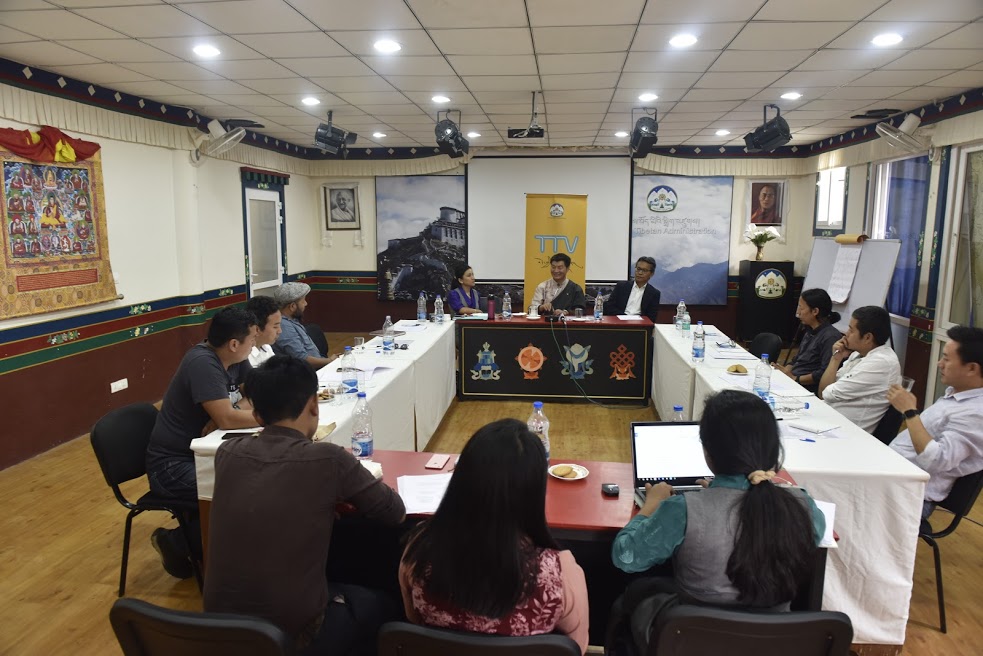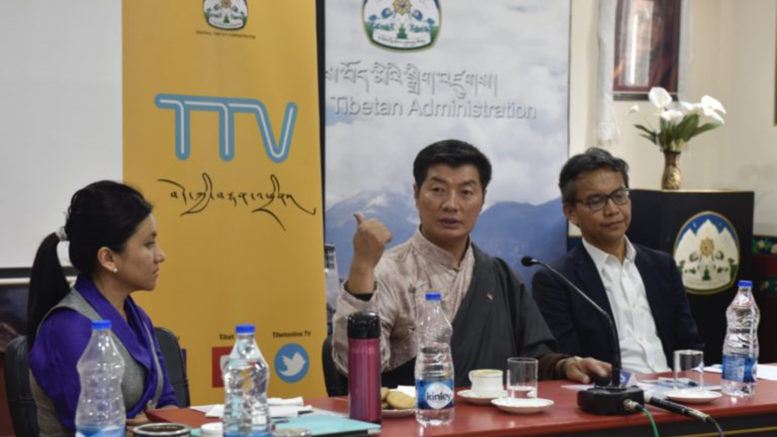Dharamshala: The three-day meeting of Consultants for Central Tibetan Administration’s (CTA) film project, convened by the Department of Information and International Relations (DIIR), kick-started today at Lhakpa Tsering Hall. The meeting scheduled from June 6 – 8, began this morning with President of CTA Dr. Lobsang Sangay also holding the portfolio of Minister for DIIR delivering the opening remarks.
President Dr. Sangay addressed the attendees on importance of establishing a narrative for the Tibet story and showcase that CTA will carry forward the struggle. He also stressed on the importance of branding component in communications strategy that could sustain and illicit interest in Tibet and CTA in the long run.
He said that the film on CTA should be able to convey to the Tibetans in Tibet that the Tibetans in exile have a well-functioning administration that works to restore freedom for Tibetans inside Tibet
Speaking on the ‘Five-Fifty Vision,’ President said the vision is premised on His Holiness the Dalai Lama’s advice to “Hope for the Best and Prepare for the Worst. The vision calls for maximizing efforts to resolve the Tibet issue in five years based on the Middle Way Approach while ensuring CTA’s resilience to sustain the Tibetan freedom struggle and preserve Tibetan culture for the next fifty years if needed.
He further said “our plan is not to stay in exile for fifty years, but our plan is to plan for fifty, if needed.”
“The film on CTA under the larger framework of the Five-Fifty Vision should depict that Tibetans can run their own government, economy, health systems. It should be able to instill a sense of hope in the Tibetans in Tibet and make them rise on their own feet, inspire them to take advantage of the Chinese education system, join the Chinese system, assert their own authority and hence assert their identity.”
Five experts in film making: Tsering Rhithar (Filmmaker based in Nepal), Tashi Tobgyal (Indian Express Journalist based in Delhi), Bhuchung D. Sonam (Writer based in Dharamsala), Sonam Tseten (Film Maker based in Delhi) and Tenzin Kalden(Filmmaker based in Dharamsala) attended the meeting. The meeting also saw the participation of Kaydor Aukatsang (Advisor for Film Project), Namgyal Tsewang (Director, Tibet TV), Tenzin Saldon (Reporter, Tibet.net) and Kelsang Dolma (CTA Media Relations intern).
Tsering Rhithar said, ” I am here to attend the meeting on 5/50-vision and how a very big scale film can be made about the 5/50 vision. The film on CTA can play a very important role in increasing the visibility and also sharing information on its functionality, its exciting work environment and also on it being a big job provider for Tibetan youth and Tibetan people. Internet is a very strong tool which has a very vast reach especially among the youth. So Tibet TV can play a very important role in sharing the information about issues related to Tibet.”
Tashi Tobgyal said, “The purpose of my attending the meeting is to come about with a set of young talented people so that we can somehow chart a good future relating to media productions, ideating and about how we can exploit the web based situations currently running so that we can secure a good future in terms of audio visual media for the Tibetan exiled people. The 5/50 documentary itself is a point where there is a unison of all the agendas, all the polices, all the campaigns and necessary resources being pulled into one and so it is a unified version of an audio visual presentation which will surely have a larger impact rather than having each agenda go alone on its own path. Smartphones nowadays are the simplest of mediums and through the web Tibet TV can connect to the farthest and the most grass roots of people and places as far as Tibetan news and programing is concerned and also its outreach is very much easier when it comes to Tibetans inside Tibet accessing any content related to their society.”
Bhuchung D. Sonam said, “I came here to take part in the 5/50 documentary film and my responsibility is to perform a background research on the documentary. Any documentary is important for creating awareness and especially 5/50 being a vision of what could possibly done in the future is really important because any vision that the government has, has to be known not only to the public but also to the international communities. In a 35 minutes documentary you can share to the people not only about the 5/50-vision but also about the history of Tibetan struggle and the people itself.”
Sonam Tseten said, “This meeting is to talk about how we are going to go about with the making of this documentary and what kind of audience we are targeting for this film. The 5/50 film could be described as a medium through which we could connect to the Tibetan people and provide them with hope and instill unity among the Tibetan people. Tibet TV so far are doing very good but as a suggestion Tibet TV could do better with a bigger studio and better equipment. We could use the Web TV which was recently introduced as a tool to broadcast Tibet TV and do more programing on Tibet issues, culture, and identity and so on.”
Tenzin Kalden said, “I have been given the role of director of photography for the 5/50-film. Media plays an extremely important role these days and through the media, being the strong channel it is, we can communicate to the people. Therefore, I think this film is important in being the bridge that connects the Tibetan people. Tibet TV also holds a great future in being that bridge which provides us with more reason to make Tibet TV better.”
Dhardon Sharling, Secretary (Equivalent) of DIIR said that the main focus of the meeting is to make a large scale, first-of-its-kind film on CTA under the framework of “Five-Fifty Vision” that will personify and humanize CTA as the nerve of Tibetan freedom struggle and as the custodian of Tibetan cultural identity. She further said that DIIR would make use of the meeting to solicit expert advice on Tibet TV’s programming section.

President of CTA Dr. Lobsang Sangay addressing the attendees of the meeting. Photo by Jayang Tsering, DIIR


